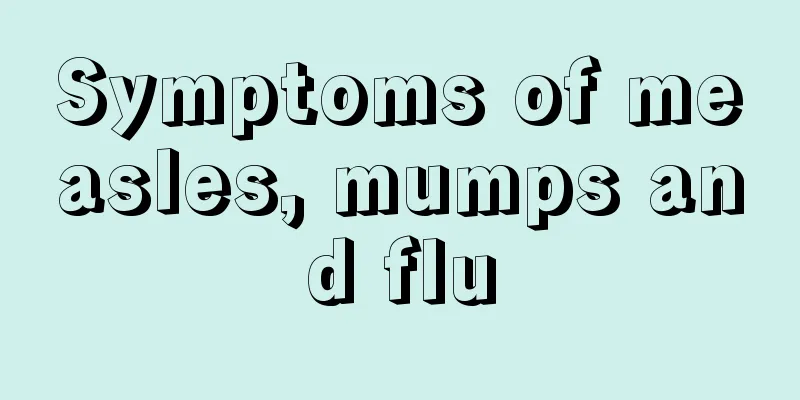What are the symptoms of internal hemorrhoid bleeding?

|
Internal hemorrhoids are a relatively common type of hemorrhoids. Almost all adults will suffer from the disease, and the incidence rate among female friends is higher than that among male friends. The most obvious symptom of internal hemorrhoids is bleeding, but because the location of the bleeding is relatively hidden, patients still need to judge based on other manifestations, such as bloody stools, prolapse, pain, etc. Symptoms of internal hemorrhoid bleeding Internal hemorrhoids grow above the dentate line. They are soft venous masses formed by the enlargement and varicose venous plexus within the submucosal hemorrhoids, and are called internal hemorrhoids. The main symptoms are bleeding and prolapse, which are mostly painless soft lumps. Long-term and repeated bleeding can cause severe anemia. Let the anorectal experts of Wuhan Boshi Anorectal Hospital explain the specific symptoms of internal hemorrhoids: The only symptom of internal hemorrhoids in the early stage is painless, intermittent, bright red blood in the stool, or blood on the stool surface, or blood on toilet paper, or bleeding in the form of drops or spurts. If the internal hemorrhoids develop further, hemorrhoids may prolapse during defecation, and in mild cases, bleeding may occur after defecation. It will return to the anus on its own. In severe cases, it may need to be pushed back in by hand. When internal hemorrhoids prolapse and are not reduced in time, incarceration edema, thrombosis, ulcers or infection may occur, causing severe pain. 1. Blood in stool: Bleeding during or after defecation, bright red in color, sometimes with a small amount of blood on the surface of the stool, or staining toilet paper red, sometimes dripping or spurting blood. Because feces abrades the mucosa, or because of excessive force during defecation, the pressure in the blood vessels increases, causing varicose veins to rupture, resulting in spurt-like bleeding during defecation. 2. Prolapse: As the volume of hemorrhoids increases, they are squeezed by feces during defecation, causing them to gradually separate from the muscle layer and prolapse out of the anus. Sometimes 1-2 hemorrhoids prolapse at the same time, and sometimes all hemorrhoids and rectal mucosa prolapse together. Initially, it only comes out during defecation and can return to its original position after defecation. For those with more severe symptoms, the prolapse must be pushed back by hand or rest in bed before it can be restored. If the symptoms are severe, in addition to prolapse during defecation, it may also occur with any exertion, walking, coughing, sneezing, squatting, etc. 3. Pain: Simple internal hemorrhoids are generally painless, and sometimes only cause a feeling of heaviness in the anus or difficulty in defecation. If the hemorrhoids are inflamed and swollen, there may be thrombosis or incarceration inside, which will cause pain; if they are prolapsed and not repositioned in time, the pain will worsen; if incarceration occurs, there is ulceration and necrosis, causing inflammation and edema of the anal margin, the pain will be severe and the patient will be restless. 4. Mucus outflow: The rectal mucosa is stimulated by hemorrhoids for a long time, causing increased secretions. In the late stage of internal hemorrhoids, secretions often flow out of the anus due to relaxation of the anal sphincter. In mild cases, it will flow out during bowel movements, and in severe cases, it will flow out naturally even when not having a bowel movement, contaminating the underwear and causing great inconvenience to the patient. When internal hemorrhoids prolapse, the discharge is greater. 5. Itching: Due to the stimulation of secretions or prolapsed hemorrhoids, the area around the anus becomes damp and unclean, causing eczema and itching. The itching is sometimes caused by the reflex action of prolapsed internal hemorrhoids. |
<<: What are the symptoms of a fungal foot infection?
>>: What causes a tingling sensation on the skin?
Recommend
Eat garlic to fight prostate cancer
Eating garlic can fight against prostate cancer. ...
Can malignant melanoma be transmitted to others?
With the popularity of If You Are the One 2, &quo...
Can I eat lettuce if I have skin allergies
Lettuce is bitter herb. Some people ask what bitt...
What causes back pain? Pay attention to back pain
Have you ever experienced back pain? In many case...
Dietary taboos for patients with endometrial cancer
Endometrial cancer is a group of epithelial malig...
What to do if a ganglion cyst ruptures
A ganglion cyst is a cystic tumor that appears in...
Is osteotomy considered a major surgery?
Osteotomy surgery generally refers to mandibular ...
What are the symptoms of gastric leiomyoma?
Gastric leiomyoma is a common type of fibroid dis...
If my stomach hurts when I stand but not when I lie down, could it be stomach cancer?
If your stomach hurts when you stand but not when...
What are the good vitamin supplements? You can drink more of these 5 types
Skin is the most important thing for women. What ...
Will bladder cancer intravenous chemotherapy cause hair loss?
Bladder cancer is the most common malignant tumor...
Can prawns and soy milk be eaten together
Shrimp is a common food in our life and many peop...
Heart rate while sleeping
Most people will find that when we enter deep sle...
What are the dangers of smoking for teenagers
Nowadays, many teenagers have started smoking. In...
What should I do if my cervical spine hurts when I sleep?
Cervical spine problems have received increasing ...









